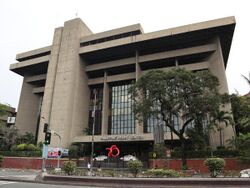Organization:Philippine Heart Center
| Philippine Heart Center | |
|---|---|
| Department of Health | |
 | |
 The hospital in 2021 | |
| Lua error in Module:Location_map at line 522: Unable to find the specified location map definition: "Module:Location map/data/Metro Manila" does not exist. | |
| Geography | |
| Location | East Avenue, Quezon City, Metro Manila, Philippines |
| Coordinates | [ ⚑ ] : 14°38′38″N 121°02′54″E / 14.64402°N 121.04842°E |
| Services | |
| Emergency department | Yes |
| History | |
| Opened | 1975[1] |
| Links | |
| Website | www |
| Lists | Hospitals in the Philippines |
The Philippine Heart Center is a hospital in Central, Quezon City, Philippines , specializing in the treatment of heart ailments. It was established in 1975.[1]
Background
The Philippine Heart Center is a hospital specializing in the treatment of heart ailments. It has rooms for paying patients and charity patients[2] and admits more than 14,000 patients every year, including 3,300 that undergo heart surgery.[3] It holds regular training programs for medical professionals.[4] It as one of the busiest congenital heart surgery centers in Asia, according to its website.[5] It is currently headed by cardiologist Joel M. Abanilla.[6][7]
History
The Philippine Heart Center was established through Presidential Decree No. 673 issued by president Ferdinand E. Marcos in 1975.[1] The building is identified with what is referred to as the Marcoses' "edifice complex,"[8][9] defined by architect Gerard Lico as "an obsession and compulsion to build edifices as a hallmark of greatness."[10] The hospital was built using 50% of the national health budget, according to Senator Jose W. Diokno, "while around the country, Filipinos were dying of curable illnesses like TB [tuberculosis], whooping cough, and dysentery."[11]
Its original name was the Philippine Heart Center for Asia and was changed to its current form in 1975. The first patient to be admitted to the PHC was Imelda Francisco, on April 14, 1975.[citation needed]
Cardiovascular specialists including Christiaan Barnard, Denton Cooley, Donald Effler, and Charles Bailey practised there.[citation needed] The first Director of the PHC was Avenilo P. Aventura (1974-1986), a cardiovascular surgeon who performed many pioneering operations in the Philippines including the first successful renal transplantation in 1970, the first CABG in 1972, and developed and implanted the first ASEAN bioprosthesis, the PHCA porcine valve.[citation needed]
In 2014, the Philippine Heart Center was given a Qmentum International Gold Accreditation for August 2014 – 2017 by Accreditation Canada International for "excellence in hospital practices and safety.[12]
Architecture and design
The hospital building was designed by Filipino architect Jorge Ramos[13] in what has been described as a Brutalist style.[14] It was built in 1975 with a reported cost of almost US$50 million.[15][page needed] It was co-founded by Dr. Ludgerio D. Torres.[13]
References
- ↑ 1.0 1.1 1.2 "Presidential Decree No. 673, s. 1975". March 19, 1975. https://www.officialgazette.gov.ph/1975/03/19/presidential-decree-no-673-s-1975/.
- ↑ Pagaduan-Araullo, Carol (March 28, 2016). "Philippine health care system, from bad to worse" (in en-US). BusinessWorld. http://www.bworldonline.com/content.php?section=Opinion&title=philippine-health-care-system-from-bad-to-worse&id=125029.
- ↑ "Welcome to PHC". https://www.phc.gov.ph/patient-guide/index.php.
- ↑ Philippine Heart Center Annual Report 2013. Philippine Heart Center.
- ↑ "Mandate". https://www.phc.gov.ph/trans/index.php?m=ma.
- ↑ "Officials". https://www.phc.gov.ph/trans/index.php?m=ab&&c=of.
- ↑ "Joel M. Abanilla, MD". https://www.phc.gov.ph/docfind/view.php?med_id=719.
- ↑ Lapeña, Carmela G.; Arquiza, Yasmin D. (September 20, 2012). "Masagana 99, Nutribun, and Imelda's 'edifice complex' of hospitals" (in en-US). GMA News Online. http://www.gmanetwork.com/news/lifestyle/healthandwellness/274389/masagana-99-nutribun-and-imelda-s-edifice-complex-of-hospitals/story/.
- ↑ Afinidad-Bernardo, Deni Rose M.. "Edifice complex | 31 years of amnesia". The Philippine Star. https://newslab.philstar.com/31-years-of-amnesia/building-spree.
- ↑ Santos, Roselle. "Book Review: Edifice Complex: Power, Myth, and the Marcos State Architecture by Gerard Lico : Philippine Art, Culture and Antiquities". http://www.artesdelasfilipinas.com/archives/45/book-review-edifice-complex-power-myth-and-the-marcos-state-architecture-by-gerard-lico.
- ↑ ""To Sing Our Own Song" (1983)". The Diokno Foundation. May 13, 2011. http://diokno.org/post/5440854729/to-sing-our-own-song-1983-this-video-is.
- ↑ Philippine Heart Center Annual Report 2014. Philippine Heart Center.
- ↑ 13.0 13.1 Villa, Kathleen de (September 16, 2017). "Imelda Marcos and her 'edifice complex'" (in en). Philippine Daily Inquirer. http://business.inquirer.net/236962/imelda-marcos-edifice-complex.
- ↑ Reyes, Anthea (September 21, 2017). "Looks like the Marcoses were Brutalists by choice" (in en-US). NOLISOLI. http://nolisoli.ph/21054/looks-like-marcoses-brutalists-choice/.
- ↑ Garcia, Myles A. (2016). Thirty years later... : catching up with the Marcos-era crimes. Quezon City, Philippines: MAG Publishing. ISBN 9780578175607. OCLC 945380506.
External links
 |


